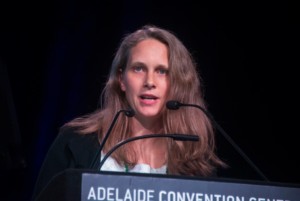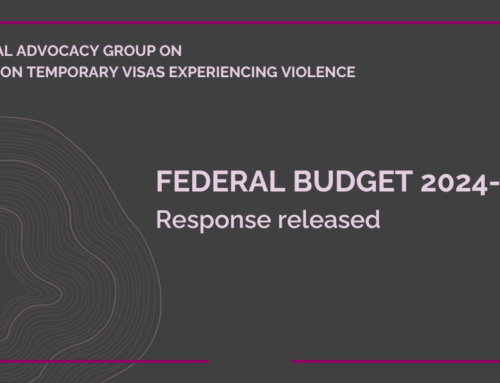AWAVA’s Program Manager, Merrindahl Andrew delivered her speech during the closing day of the Prevalent and Preventable Violence against Women conference which was held in Adelaide from 19 to 22 of September 2016.
I want to address a question that’s been raised several times in the conference, which is how to build on the momentum we have at the moment, and keep it going: how to push for the social change that is required to meet our shared goal.
Worldwide, the most important factor influencing government responses to violence against women is the presence of a strong, autonomous feminist movement.
In their study of 70 countries Laurel Weldon & Mala Htun found that the presence of such a movement was more influential than any other factor in achieving the broad range of government responses that support victims and survivors, and work towards eliminating violence.
Strong, autonomous women’s movements make more of a difference than national wealth, left-wing parties, or the number of women legislators.
However, Weldon & Htun did also find that women’s policy agencies and international norms strengthen feminist efforts, as movements work within and across borders and demand the creation of new institutions to advance feminist interests.
What does autonomous mean? Well, Weldon & Htun defined it simply as meaning autonomous from organisations that do not have gender equality as their primary goal, such as political parties and unions. So it doesn’t necessarily mean small, or non-hierarchical, or having a philosophy of any particular degree of radical-ness: it just means not subsumed within a broader organisation that’s not focused specifically on gender equality.
But social science can only give findings about past patterns of how people achieved social change. There is no instruction manual; we still have to decide what to do in the present, with incomplete information. Partly because things change even as we’re trying to change them, and because we also change in that process.
An image that came to me in one of the sleepless nights leading up to this conference is that doing this kind of social change is like trying to stir a pot of hot custard with a spoon made of chocolate.
It can be frustrating and messy, and you might end up holding nothing, but what we’re making is pretty good.
Beyond that, I do not advise relying on this metaphor!
Weldon and Htun’s research was limited, as all research must be, by certain definitions: in their case they were focused on what determined the extent of governments’ responses to violence against women. They were mainly measuring things like government funding for refuges, shelters and rape crisis centres, law reform, and training for workers such as police. All things that still concern us today.
But what about the next step that we’re trying to make: to a national and local focus on prevention, to a concerted effort to change the underlying drivers of violence. An effort that obviously involves a wide range of actors beyond as well as including governments.
As we have seen at this conference, and as Our Watch has articulated so well in Change the Story – this involves working towards a situation where messages and influences about equality, respect and non-violence are coming from all directions and in all settings – reinforcing and multiple.
What is the factor that is going to get us there? Our Watch plays a key role, and its member governments can be hugely influential if they bring that influence to bear – but who is going to persuade them to bring that influence to bear? Change needs to come from so many more people and institutions. It’s almost as if what we need is – An autonomous feminist movement! Or something new along those lines that is being created right now.
Actually – this kind of systemic change is something that the Australian feminist movement has always been working towards. The great debates about ‘reform vs revolution’ in the 1970s and 1980s were basically resolved along the lines of:
It’s OK to work for reform as long as by doing so you’re strengthening and not undermining the chances for revolution.
It’s a question that’s still worth asking – what are the implications of our actions?
Meanwhile, the feminist movement itself has changed. Is that the term we even want to use now?
You could say that the groups that are organised towards reform (and maybe still revolution!) are now less autonomous than in the past, because they’re more linked in with other institutions – which is partly a gain, since that kind of institutionalisation is one of the ways feminist movements ultimately achieve change.
You could say that AWAVA falls into that category.
On the other hand, the newer and more autonomous groups – often operating through social media and localised/informal networks, and in various specific settings – are mobilising opinion, leading through influence, creating connections and giving voice to experiences that are deeply relevant but not represented in mainstream portrayals of violence against women.
One of the constructive things that we can do to strengthen the links between the more institutionalised parts of the movement – the parts that have a degree of legitimacy or power because of our place in broader institutions – and the more autonomous and perhaps less powerful parts.
But without trying to force everybody into some grand scheme, and with the kind of respect that makes it safe and humane for everyone.
Another constructive thing we can do is look to the contribution of women’s organisations and women’s services over the last forty years, and re-articulate the principles developed:
- individual and systemic advocacy,
- contributing to social change and policy development while drawing on women’s experiences,
- non-victim-blaming,
- recognising the individual woman as the expert in her situation
- knowledgeable about the patterns of violence and what’s required for healing
– a powerful, effective model that goes way beyond the shorthand description of ‘response’, as it’s used to distinguish services from ‘prevention’.
Wherever it works to do so, let’s make sure that prevention efforts and broader advocacy are linked to this model.
On Tuesday, Maha Abdo from the Muslim Women’s Association encouraged us to acknowledge and sit with what is uncomfortable. In that spirit, I want to acknowledge that every time I say ‘we’, I feel uncomfortable because I have not defined ‘we’, or asked any of you on what terms you might like to be included in this ‘we’.
It’s the poetic, political ‘we’ of ‘we, the people’, it’s an attempt to construct a collective – and it always threatens to be a form of domination: as in, ‘are you with us, or against us?’
This is part of the history of the women’s movement, and why intersectionality is so important.
The other problem with ‘we’ is the tendency towards a kind of romanticised notion of ‘us against the world’ – or worse still: ‘we few, we happy few’, glorious and honourable even in our likely failure.
We do not want to be few! We want to be many! We do not intend to fail; we plan to succeed!
That’s one of the great contributions of Our Watch, among others: to have such big and open ambition about the scale that we want to have, the number of people we want to mobilise, beyond our own groups, backgrounds and political positions.
So, please take my use of ‘we’ as contingent, as provisional, if possible as an opening rather than a closure. And I will continue to acknowledge the discomfort.
As good as recent developments have been, sometimes in our area it feels as if there’s a terrible lack of traction. We can see the urgency and the horror of what we’re dealing with, but it feels like our wheels are spinning –the institutions around us often fail to respond with commensurate attention – sustained attention, realistic resources, an extra shoulder to the bumper of a badly bogged car.
There is progress, and at times there are hope-inspiring leaps of progress –
- like when Our Watch produced Change the Story;
- like when Australia’s Prime Minister acknowledged that gender inequality underpins this violence;
- like when the Victorian Government commissioned and then committed to implementing – and funding! – perhaps the most extensive and systematic inquiry into domestic and family violence ever undertaken.
And then – perhaps even at the same time – we are confronted by the sheer inadequacy of every step taken so far.
There are two things I think that can give us comfort and hope.
One thing is to look to each other for inspiration and to honour each other’s work, acknowledging that we all sit in different positions, with different roles and limitations, and with lives beyond as well as linked to violence.
The other thing is that it all adds up. We don’t have to do it all ourselves – we can’t.
I went to a great speech once by Mark Yettica-Paulson, and to encourage the audience he quoted the song by Kev Carmody and Paul Kelly – not the famous line ‘from little things big things grow’ – but the line that says:
‘If we fall others are rising.’
In the song, that’s Vincent Lingiarri’s defiance, his warning to the powerful land-holders that the Gurindji’s efforts will be sustained beyond individuals. We have some of that same determination, that longevity, in our efforts to eliminate violence.
Marai Larasi reminded us that ultimately we want to be out of a job. The double bind is that in order to get there, we need to be able to do our jobs.
We have to acknowledge that our world is quite harsh in rewarding status and credibility, and punishing those who lack it, or are seen to lack it.
We have to not let our own need for status and credibility, as organisations and individuals, squeeze out, push down on others.
We have to make space for those others who are rising, and we have to create enough shared resources, networks, knowledge, goodwill, trust, friendships – so that they’re rising into something they can take hold of and make something from.


